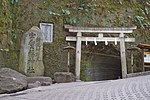Kōtoku-in
13th-century Buddhist templesBuddhist temples in Kamakura, KanagawaColossal Buddha statuesNational Treasures of JapanOutdoor sculptures in Japan ... and 3 more
Pure Land templesReligious buildings and structures completed in 1243Temples of Amitābha

Kōtoku-in (高徳院) is a Buddhist temple of the Jōdo-shū sect, in the city of Kamakura in Kanagawa Prefecture, Japan. Its mountain name is Taiizan (大異山), and its common temple name is Shōjōsen-ji (清浄泉寺). The temple is renowned for The Great Buddha of Kamakura (鎌倉大仏, Kamakura Daibutsu), a monumental outdoor bronze statue of Amitābha, which is one of the most famous icons of Japan. It is also a designated National Treasure, and one of the twenty-two historic sites included in Kamakura's proposal for inclusion in UNESCO's World Heritage Sites.
Excerpt from the Wikipedia article Kōtoku-in (License: CC BY-SA 3.0, Authors, Images).Kōtoku-in
Kamakura
Geographical coordinates (GPS) Address Phone number Website External links Nearby Places Show on map
Geographical coordinates (GPS)
| Latitude | Longitude |
|---|---|
| N 35.31684 ° | E 139.53573 ° |
Address
高徳院
鎌倉市長谷4-2-28
248-0016 Kamakura
Japan
Open on Google Maps










